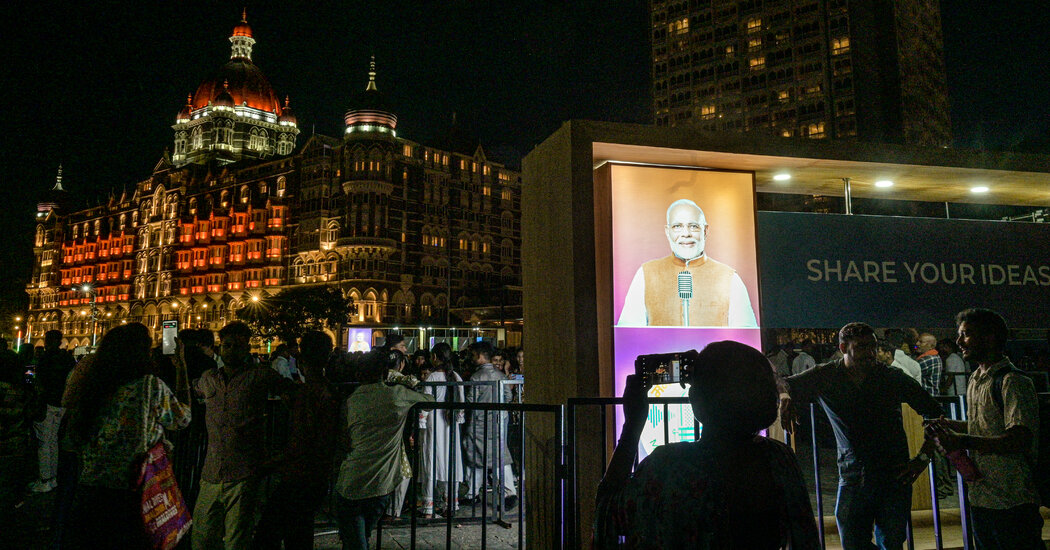2,000-Pound Bombs Likely Used in Mawasi Strike
Large craters and a bomb fragment from an Israeli airstrike on a camp for displaced people early Tuesday provide strong evidence that Israel used 2,000-pound bombs, according to three weapons experts.
The United States has previously warned Israel that the powerful munitions can cause excessive civilian casualties in the densely populated Gaza Strip, and suspended exporting U.S.-made 2,000-pound bombs to Israel earlier this year.
Israel said it had carried out “precise strikes” aimed at Hamas militants, but has so far declined to say what sort of bombs were used. At least 19 people were killed in the blasts and more than 60 others injured, Gazan authorities said, a toll that appeared likely to rise. Health officials in Gaza do not distinguish between civilians and combatants when reporting casualties.
Video filmed after the attack and verified by The New York Times showed two enormous blast craters measuring close to 50 feet wide. Satellite imagery captured on Monday showed no craters at the location, confirming they were new.
One of the weapons experts — Chris Cobb-Smith, a former British Army artillery officer and director of Chiron Resources, a security and logistics agency told The Times that the dimensions of the craters were broadly consistent with the use of 2,000-pound munitions.
“The dimensions of the crater indicate it’s likely that this strike involved the use of a 2,000-pound aerial dropped bomb by the I.D.F.,” Mr Cobb-Smith said, referring to the Israel Defense Forces.
A second expert, Trevor Ball, a former U.S. Army explosive ordnance disposal technician, identified a weapons fragment found at the scene as “the tail section of a SPICE-2000 kit,” a precision guidance kit that is used with 2,000-pound bombs.
A third expert, Patrick Senft, at the consulting firm Armament Research Services, also said that “one fragment is visually consistent with the tail section of a SPICE 2000 guidance kit, suggesting that at least one 2,000-pound bomb was employed.” He noted that the large craters also indicated the use of a heavyweight bomb.
In its campaign in Gaza, Israel has routinely used 2,000-pound bombs, which shatter into razor-sharp fragments that can kill or incapacitate people over several hundred feet.
When Washington suspended the export of U.S.-made 2,000-pound bombs in May, officials said their use could lead to wide civilian casualties and were not needed by the Israelis. Biden administration officials said at the time they were especially worried about the damage that could be done by such bombs in a crowded area with many displaced civilians.
Mr. Cobb-Smith underscored that concern, saying, “Such bombs have the technological ability to be highly accurate, but I consider the use of a munition in a densely populated area, and one designated as a ‘safe zone’ to be disproportionate.”
The area targeted in Khan Younis was part of a humanitarian zone that Gazans had been instructed to move to. Satellite imagery reviewed by The Times shows that temporary structures, including tents, began to fill the area starting in February and expanded through the year, especially following evacuation orders in the southern city of Rafah in May.
Images captured by witnesses and local journalists posted online on Tuesday morning and verified by The New York Times showed a devastating scene as emergency service workers and other residents used shovels and their hands to try to find bodies in and around the craters.
Other videos, also verified by The Times show furniture, clothes and other household items strewn around a wide area, and a car almost completely immersed under the sand. What appeared to be greenhouses situated adjacent to the strike were mostly destroyed.
In satellite imagery captured about a day before the attack, around a dozen tents and other temporary structures can be seen in the area that was directly hit. They were destroyed in the attack, as were dozens of other tents surrounding the area, which could no longer be seen in photos and videos of the aftermath.
The area was previously targeted by Israeli airstrikes, including a similar attack using 2,000-pound bombs in July targeting a top Hamas commander, Mohammed Deif, less than two miles away.


